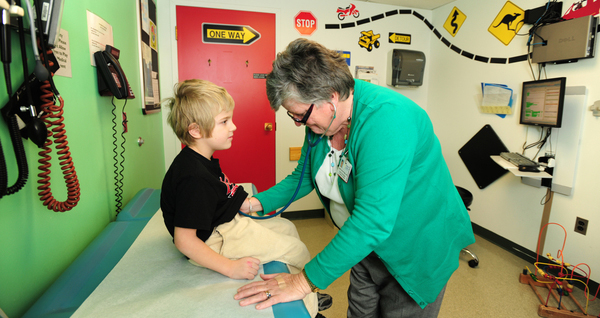Amid the extensive coverage of a growing Ebola epidemic last fall came news that President Obama had signed an executive order to combat what could become an even more invasive world health threat: antibiotic-resistant bacteria.
“The evolution of antibiotic resistance is now occurring at an alarming rate and is outpacing the development of new countermeasures capable of thwarting infections in humans,” declared an accompanying report from the President’s Council of Advisors on Science and Technology. “This situation threatens patient care, economic growth, public health, agriculture, economic security, and national security.”
The World Health Organization similarly has warned that a “post-antibiotic era – in which common infections and minor injuries can kill – far from being an apocalyptic fantasy, is instead a very real possibility for the 21st century.”
To do its part in the fight against antibiotic resistance, the Vermont Department of Health has joined the U.S. Centers for Disease Control’s (CDC) “Get Smart” program to educate patients and health care providers about proper antibiotic use, says Patsy Kelso, Ph.D., state epidemiologist.
Now that it’s cold and flu season, it’s an ideal time to issue reminders about when – and when not – to prescribe antibiotics.
“Germs that cause colds and flu thrive in winter, resulting in symptoms that make people feel miserable,” Kelso explains. “Antibiotics treat bacterial infections, but they won’t touch an infection caused by a virus, which is the likely culprit for most stuffy noses, sore throats and coughs.”
What is the impact of antibiotic-resistant bacteria?
Overuse and improper use of antibiotics leads to bacterial resistance. It allows infectious organisms to adapt to antibiotics, making drugs less effective. This leaves patients vulnerable to a number of serious infections, such as carbapenem resistant Enterobacteriaceae (CRE), Clostridium difficile (C. diff) and Methicillin‐resistant Staphylococcus Aureus (MRSA),
Each year, 23,000 Americans die and 2 million get sick from antibiotic-resistant infections, according to the CDC. More than half of all deaths are caused by a C. diff – a bacterial infection that causes severe diarrhea and leads to at least 250,000 infections and 14,000 deaths each year in hospitalized patients.
The annual impact of antibiotic resistance on the U.S. economy is estimated at $20 billion to $35 billion in excess direct health care costs, and as much as $35 billion in lost productivity due to missed work time, the CDC says.
Another issue complicated by antibiotic resistance, according to a CDC report on “Antibiotic Resistance Threats in the United States”: “Many of the advances in medical treatment – joint replacements, organ transplants, cancer therapy, and treatment of chronic diseases such as diabetes, asthma, rheumatoid arthritis – are dependent on the ability to fight infections with antibiotics. If that ability is lost, the ability to safely offer people many life-saving and life-improving modern medical advantages will be lost with it.”
How ‘Get Smart’ is getting out the word
The “Get Smart” program is aimed at educating health care providers, hospital administrators, policy makers and patients about the need to decrease inappropriate antibiotic use.
For instance, the Vermont Health Department issued an advisory to providers and pharmacists alerting them to updated guidelines from the American Academy of Pediatrics that promote more stringent criteria in diagnosing ear infections, which could potentially limit antibiotic use. The Health Department also has run an advertising campaign, sponsored a video contest for university students, printed informational inserts for pharmacy bags and organized a continuing medical education event for health care providers to raise awareness about proper antibiotic use.
Americans’ attitudes toward antibiotics
Americans don’t always understand the link between their individual antibiotic use and the greater threat of antibiotic resistance.
Kelso points to a Pew Health Group report on Americans’ Knowledge of and Attitudes Toward Antibiotic Resistance. It indicates that Americans seem aware of what causes antibiotic resistance. However, many don’t always follow through on their best intentions regarding proper antibiotic use.
The report notes that:
- 86 percent of those surveyed knew they should complete a full course of antibiotics even if their symptoms disappeared. Yet many admitted to stopping mid-course when they felt better, often because they didn’t like the side effects or taking what they perceived to be “unnecessary” medicine.
- 87 percent of those surveyed understood that antibiotics are effective for fighting bacterial infections, such as strep throat and some sinus infections. Yet 36 percent incorrectly believed that antibiotics could treat viruses such as the flu and common cold.
- Less than half (47 percent) said that taking antibiotics when you don’t need them can weaken their effectiveness for others in the community, and 39 percent believed an individual’s antibiotic use has no impact on the rest of the community.
Doctors’ perceptions regarding antibiotics
The “Get Smart” campaign also is supporting health care providers in their goal to decrease antibiotic use. Doctors sometimes feel pressure from patients – and especially parents of young children – to prescribe antibiotics when children come down with a cold or cough, Kelso says.
However, parents don’t always ask for the antibiotics when they visit the doctor’s office; doctors just think they want them.
“When doctors are surveyed, it turns out they over perceive sometimes how much patients expect antibiotics when they haven’t indicated they want them,” she says. “That is one message we have been educating Vermont health care providers about.”
Dr. Kelso shares these statistics from CDC surveys:
- Only 26 percent of patients visiting the doctor’s office with a cough or cold sought an antibiotic while 42 percent simply wanted a health care provider to rule out an infection and 35 percent wanted relief for their symptoms.
- Yet 54 percent of health care providers believed that patients were visiting the doctor’s office to obtain an antibiotic.
That misperception, Kelso believes, could lead to more doctors prescribing antibiotics when they don’t need to.
Still, there are patients – often parents of young children – who push doctors for an antibiotic, she says.
“Parents tell the doctor, ‘The last time my kid was sick he had this antibiotic, and felt better in a few days,’ ” she says. “But it could be that the antibiotic that they got last time had nothing to do with their child getting better. Sometimes, it takes less time to write a prescription than to explain to a parent why you aren’t writing a prescription.”
A solution for doctors and patients
To help health care providers caught in this situation, The Health Department provides a prescription sheet instead of an actual prescription for antibiotics.
“If a doctor isn’t going to write a prescription for an antibiotic, then he or she can give the patient this sheet,” she explains. “It says: Here’s what you can do to feel better; here’s what you can take if you have a fever or aches. If you’re not better in a few days, here’s what you can do. The idea is that people walk away from the doctor’s office knowing that the doctor listened, but didn’t give them something that won’t help and in fact could be harmful.”
How to get better when you have a virus
According to the CDC, there are additional steps patients can take to treat viruses, including:
- Ask your healthcare professional about over-the-counter treatment options that may help reduce symptoms of viral infections. Remember that colds, flu, most sore throats, bronchitis, and many sinus or ear infections cannot be treated with antibiotics.
- Drink more fluids.
- Get plenty of rest.
- Use a cool-mist vaporizer or saline nasal spray to relieve congestion.
- Soothe your throat with crushed ice, sore throat spray, or lozenges. (Do not give lozenges to young children.)
- Avoid smoking, second-hand smoke, and other pollutants (airborne chemicals or irritants).
- Take acetaminophen, ibuprofen or naproxen to relieve pain or fever. Know what is safe to give your child.
- If you are diagnosed with the flu, consider asking for a prescription antiviral drug that can be used to treat flu illness.
- For ear pain, put a warm moist cloth over the ear that hurts.
- For sinus pain, put a warm compress over your nose and forehead to help relieve sinus pressure, breathe in steam from a bowl of hot water or shower.
- For a cough, use a clean humidifier or cool mist vaporizer or breathe in steam from a bowl of hot water or shower.
- Wash your hands with soap and water. If soap and water are not available then use hand sanitizer.





